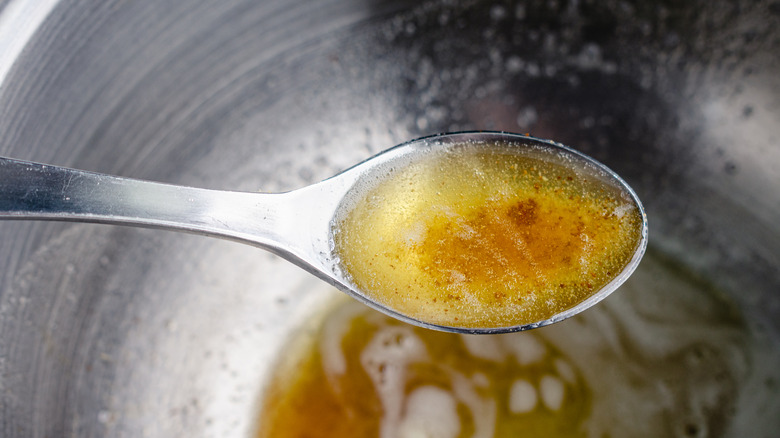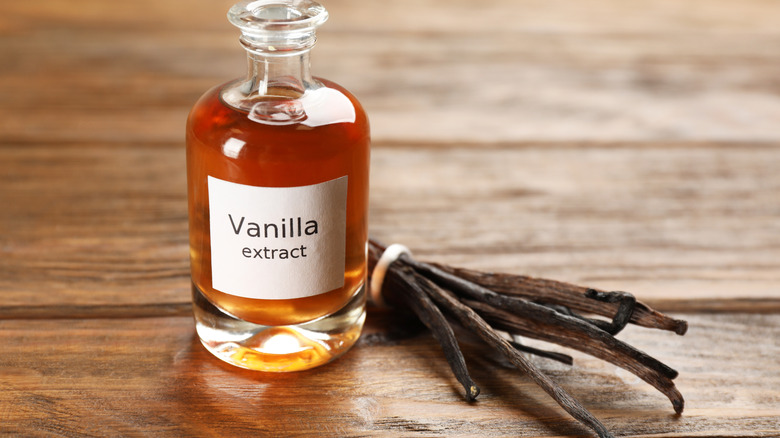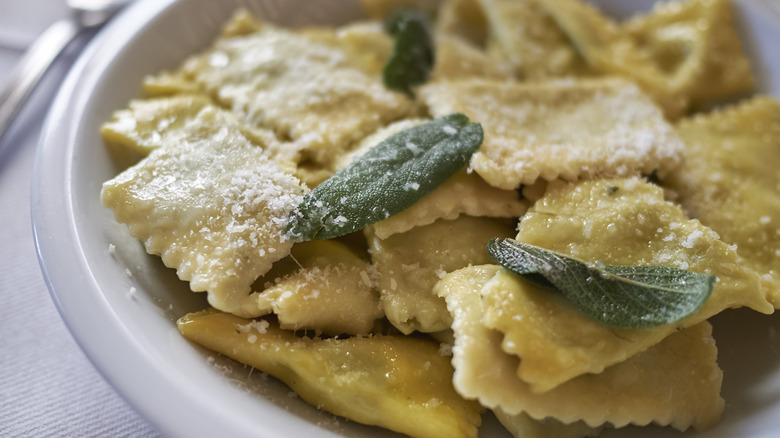Vanilla Amplifies Brown Butter In More Dishes Than You'd Think
Butter and vanilla are fundamental baking ingredients. Vanilla is as ubiquitous in baking as salt and pepper are in cooking, and butter is a foundation for both sweet and savory dishes. Especially brown butter, which is really having its moment. According to Tastewise, brown butter mentions are up over 26% in the last year. That upward trend is surprising for a technique that's no newcomer to kitchens.
Beurre noisette is the French term for browned butter (per MasterClass). The color is a light brown and it does have a nutty flavor, which leads to that name being translated to hazelnut butter. To make brown butter, heat it in a light-colored pan until the butter splits into butterfat, which floats, and milk solids, which will sink to the bottom. You shouldn't use a dark-colored pan when making brown butter because as the water evaporates, those milk solids caramelize. Judging when it's done is based on the color of those solids. In a dark pan, you can't see that change.
Brown butter can be turned into a pan sauce with a few additions, or allowed to cool and subbed for regular butter in baked goods. The extra nuttiness will take chocolate chip cookies to the next level. If vanilla and brown butter play so well together in cookies, why not give it a try in something other than dessert?
Vanilla is a powerful flavor enhancer
In "The Flavor Bible" authors, Karen Page and Andrew Dornenburg, created an encyclopedic list of ingredients and flavors that pair well with them. Vanilla has a long list of over 75 pairings, from allspice to yogurt. In between, you'll find black beans, cilantro, mussels, and tomatoes. Of course, brown butter is on that list.
Beth Nielsen is a co-owner of vanilla extract maker Nielsen-Massey and calls vanilla "Mother Nature's MSG" for its ability to enhance other flavors (via TASTE). Adding vanilla to brown butter will amplify the nutty and caramel flavor, without it becoming obviously vanilla flavored. Nielsen cites their habit of adding some vanilla to pasta sauce, mentioning that a dose of vanilla really heightens the herbs along with the rest of the ingredients.
Vanilla beans aren't a common kitchen ingredient and are prone to wild price fluctuations that are near an all-time high (per Bloomberg). Vanilla extract prices, like Nielsen-Massey, are still high but less volatile. Plus, it's a familiar, easy-to-incorporate ingredient. As a bonus, the vanilla extract contains alcohol, which is another powerful flavor enhancer. In conjunction with vanilla, the alcohol will enhance flavor release and sensory perception.
Vanilla and brown butter are a perfect pair
How did "vanilla" come to mean (per Merriam-Webster) plain and ordinary? It doesn't taste plain. Ordinary might make sense as it is such a common ingredient. But, because of its flavor-enhancing superpowers, it should be even more common.
Nielsen continues in TASTE to explain that Nielsen-Massey uses vanilla to heighten the mundane, like brown butter mashed sweet potatoes, or something more complex, like vanilla cured smoked salmon with parmesan black pepper crisps.
In some cases, the alcohol in the extract can be too harsh, so always start with a small amount. One-half teaspoon might be enough for an entire dressing recipe. Brown butter apple tart is a great example of how brown butter's flavor is enhanced with a dash of vanilla extract.
Vanilla bean paste is another vanilla option that can be substituted for whole beans or extract. As a bonus, this paste can be used as a glaze for seafood, pork, or poultry. Butternut squash ravioli is a classic brown butter recipe that could use a teaspoon of vanilla paste whisked into the brown butter before dressing the pasta.


